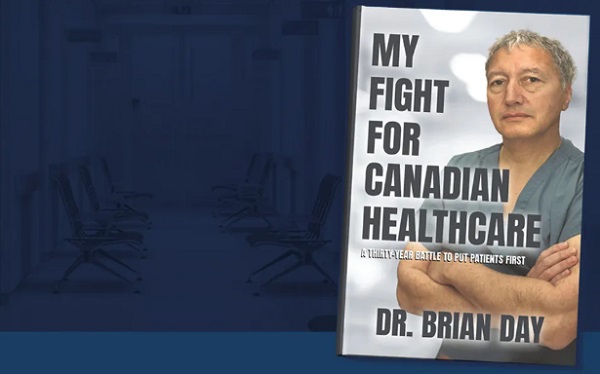Fraser Institute
One doctor’s battle to put patients ahead of politics

From the Fraser Institute
For decades, Canadians have been told that our health-care system is the envy of the world, a symbol of national pride. But the reality, as exposed in the new book My Fight for Canadian Healthcare by Dr. Brian Day, is far less flattering—and far more troubling. Dr. Day’s account of his 30-year battle to put patients first reveals a system bogged down by ideology, political inertia and an aversion to necessary reform. His message is clear: it’s time for Canadians to take off the rose-coloured glasses and demand a system that actually works for patients.
The book is not an argument for dismantling universal health care—it’s a plea for modernization and responsiveness. Dr. Day, an orthopedic surgeon and founder of the Cambie Surgery Centre in Vancouver, offers a front-line perspective on how rationing, administrative inefficiency and outdated policies systematically deny timely care to patients. Through detailed stories and compelling data, he documents the tragic human cost of excessive waiting lists—patients suffering needless pain, enduring irreversible deterioration, and in some cases, dying of preventable deaths.
One of the most disturbing revelations in the book is the deliberate limitation of health-care capacity by provincial governments. Faced with budget constraints, administrators limit operating room time and restrict physician access, effectively forcing patients to suffer on long waiting lists. This isn’t the result of unavoidable resource shortages; it’s a consequence of deliberate policy choices aimed at controlling spending, even if that means denying patients the care they need when they need it.
What makes this all the more unacceptable is that many of the very politicians and bureaucrats who defend this system seek care in private clinics (including Dr. Day’s Cambie Surgery Centre) when their own health is on the line. This double standard—one system for the public, another for the elite—undermines the entire moral justification of Canada’s approach to health care. If the system were truly world-class, those in power would not seek alternatives.
Dr. Day’s legal battle began in 2009 when his clinic became the target of a government lawsuit for allegedly violating an existing prohibition on patients paying with their own money for medically necessary care. This same prohibition had already been found unconstitutional in Quebec by the Supreme Court’s Chaoulli ruling in 2005, on the grounds that it violated fundamental rights to life and security.
The case dragged on for more than a decade, exposing the dysfunction of both the health-care system and the legal process meant to evaluate its constitutionality. Evidence presented in court—including government data showing thousands of patients dying while waiting for care—was damning. Unfortunately for Canadians, the British Columbia Supreme Court ultimately upheld the government’s authority to ration care and forbid patients from seeking private alternatives.
This legal defeat underscores a core truth that Dr. Day has long emphasized—Canadian health care is driven more by ideology than by evidence. The obsession with preserving a government monopoly has become an end in itself, eclipsing the system’s primary purpose: ensuring timely quality care for all. In no other sphere of life would we tolerate this. Imagine being told you couldn’t pay for private tutoring if your child’s public school was failing him. Yet this is precisely what Canadian health-care policy imposes.
Crucially, Dr. Day’s critique is rooted not in theory but in practise. He has seen firsthand the harm caused by delays, the deterioration of patients left waiting months or years for treatment, and the exodus of talented young doctors who leave Canada because the system restricts their ability of practise to their full potential. He has also seen the benefits of mixed public-private models in countries such as Australia, Sweden and Germany—countries with universal care that still allow room for private-sector innovation and competition.
Predictably, critics paint Dr. Day as a champion of privatization at any cost, but this is a gross mischaracterization. His vision is not American-style health care but rather a modernized patient-centred system that retains universal coverage while embracing flexibility, innovation and patient choice. In short, he wants Canada to catch up with the rest of the developed world, where public and private systems work together to ensure patients receive timely care regardless of their financial means.
Perhaps the most sobering aspect of My Fight for Canadian Healthcare is the reminder that reform is not only necessary, but inevitable. Canada’s population is aging, demand for care is rising, and the costs of maintaining the current system are unsustainable. Clinging to outdated structures will only deepen the crisis. The choice is not between public and private care—it’s between a system that works and one that fails.
As Dr. Day argues, the ultimate victims of our broken system are the patients themselves—ordinary Canadians left to suffer while politicians cling to outdated dogma. His fight has been long and costly, but it offers a valuable lesson: health-care reform is not about ideology. It’s about compassion, common sense and the courage to admit when something isn’t working. The time for that honesty is now.
Business
Ottawa’s gun ‘buyback’ program will cost billions—and for no good reason

From the Fraser Institute
By Gary Mauser
The government told Cape Bretoners they had two weeks to surrender their firearms to qualify for reimbursement or “buyback.” The pilot project netted a grand total of 22 firearms.
Five years after then-prime minister Justin Trudeau banned more than 100,000 types of so-called “assault-style firearms,” the federal government recently made the first attempt to force Canadians to surrender these firearms.
It didn’t go well.
The police chief in Cape Breton, Nova Scotia, volunteered to run a pilot “buyback” project, which began last month. The government told Cape Bretoners they had two weeks to surrender their firearms to qualify for reimbursement or “buyback.” The pilot project netted a grand total of 22 firearms.
This failure should surprise no one. Back in 2018, a survey of “stakeholders” warned the government that firearms owners wouldn’t support such a gun ban. According to Prime Minister Carney’s own Privy Council Office the “program faces a risk of non-compliance.” And federal Public Safety Minister Gary Anandasangaree was recently recorded admitting that the “buyback” is a partisan maneuver, and if it were up to him, he’d scrap it. What’s surprising is Ottawa’s persistence, particularly given the change in the government and the opportunity to discard ineffective policies.
So what’s really going on here?
One thing is for certain—this program is not, and never has been, about public safety. According to a report from the federal Department of Justice, almost all guns used in crimes in Canada, including in big cities such as Toronto, are possessed illegally by criminals, with many smuggled in from the United States. And according to Ontario’s solicitor general, more than 90 per cent of guns used in crimes in the province are illegally imported from the U.S. Obviously, the “buyback” program will have no effect on these guns possessed illegally by criminals.
Moreover, Canadian firearms owners are exceptionally law-abiding and less likely to commit murder than other Canadians. That also should not be surprising. To own a firearm in Canada, you must obtain a Possession and Acquisition Licence (PAL) from the RCMP after initial vetting and daily monitoring for possible criminal activity. Between 2000 and 2020, an average of 12 PAL-holders per year were accused of homicide, out of approximately two million PAL-holders. During that same 10-year period, the PAL-holder firearms homicide rate was 0.63 (per 100,000 PAL-holders) compared to 0.72 (per 100,000 adult Canadians)—that’s 14 per cent higher than the rate for PAL-holders.
In other words, neither the so-called “assault-style firearms” nor their owners pose a threat to the public.
And the government’s own actions belie its claims. If these firearms are such a threat to Canadians, why slow-roll the “buyback” program? If inaction increased the likelihood of criminality by law-abiding firearms owners, why wait five years before launching a pilot program in a small community such as Cape Breton? And why continue to extend the amnesty period for another year, which the government did last month at the same time its pilot project netted a mere 22 firearms?
To ask those questions is to answer them.
Another question—how much will the “buyback” program cost taxpayers?
The government continues to block any attempt to disclose the full financial costs (although the Canadian Taxpayers Federation has launched a lawsuit to try to force the government to honour its Access to Information Act request). But back in 2020 the Trudeau government said it would cost $200 million to compensate firearms owners (although the Parliamentary Budget Officer said compensation costs could reach $756 million). By 2024, the program had spent $67.2 million—remember, that’s before it collected a single gun. The government recently said the program’s administrative costs (safe storage, destruction of hundreds of thousands of firearms, etc.) would reach an estimated $1.8 billion. And according to Carney’s first budget released in November, his government will spend $364 million on the program this fiscal year—at a time of massive federal deficits and debt.
This is reminiscent of the Chretien government’s gun registry fiasco, which wound up costing more than $2 billion even after then-justice minister Allan Rock promised the registry program would “almost break even” after an $85 million initial cost. The Harper government finally scrapped the registry in 2012.
As the Carney government clings to the policies of its predecessor, Canadians should understand the true nature of Ottawa’s gun “buyback” program and its costs.
Business
Recent price declines don’t solve Toronto’s housing affordability crisis

From the Fraser Institute
By Jake Fuss and Austin Thompson
House prices in Toronto are declining. But the city’s affordability crisis is far from over—and government policies will likely make it worse.
While most Torontonians know there’s a crisis, the numbers make it clear. According to our new study, in 2023 (the latest year of available data), a family earning the city’s median after-tax income ($60,510) had to save $216,240 (the equivalent of 42.9 months of its after-tax income) for a 20 per cent downpayment on a typical home of any type (single-detached, semi-detached, condominium). But even if that family could somehow clear this monumental hurdle, it then had to dedicate 110.2 per cent of its after-tax income for monthly mortgage payments ($5,557)—a financial impossibility, unless the family can share housing costs (e.g. live-in tenants) or rely on financial support from elsewhere.
At this point, some long-time Toronto residents might recall their own difficult home purchase and think, “Hasn’t it always been this bad?” But just a decade ago, the hurdles weren’t nearly as high.
For example, in 2014 in Toronto, a 20 per cent downpayment cost 26.4 months of median after-tax family income—not 42.9 months. And the monthly mortgage payment on a typical home purchase required 56.0 per cent of median after-tax family income—not 110.2 per cent. So yes, typical homes have been broadly unaffordable for median-income-earning Toronto families for years, but it’s way worse now.
For Torontonians priced out of homeownership, renting has not offered much relief. In 2023, Toronto had the least affordable rents in Canada. The monthly cost of the median rental unit was $1,750, equal to 34.7 per cent of the median after-tax family income. That’s up from $1,110 (or 27.7 per cent of after-tax income) in 2014.
Fast-forward to today, and Torontonians should view reports of “crashing” home prices in the proper context. Typical home prices peaked at $1.27 million in the first quarter of 2022. By the second quarter of 2025, they had fallen to $1.00 million. That’s a marked decline, but prices remain well above pre-pandemic levels and far beyond the reach of most typical families.
And while the fall in house prices hasn’t been enough to restore affordability, it has caused a steep contraction in homebuilding as builders take a more cautious approach to development at a time when the city still needs more new homes to improve affordability.
This unhealthy dynamic, where price declines weigh heavily on housing construction, is made worse by government policy. Despite hundreds of millions of taxpayer dollars spent on housing initiatives by the federal government, the Ford government and Toronto City Hall, key provincial and municipal policies continue to impose needless costs and restrictions on new housing.
For example, Toronto homebuilders must endure costly wait times of more than two years for municipal approvals—more than three times longer than in Vancouver and seven times longer than in Edmonton. New high-rise developments in Toronto face municipal charges of $134,900 per unit compared to $38,100 in Ottawa and $6,900 in Edmonton. Meanwhile, the Ford government has backed away from several critical recommendations from its own Housing Task Force, which would make it easier to build more and denser housing, such as allowing fourplexes provincewide without special approval.
Of course, federal immigration policy, particularly over the last five years, has increased demand for new homes in Toronto and across the country. But even so, if not for lengthy approval processes, sky-high fees and restrictive land-use policies, many more new homes would be built in Toronto today despite declining prices. Homes only get built when buyers can cover the cost of construction plus a reasonable return on investment for developers. But when governments drive up costs, increase uncertainty and claim a significant share of the final sale price through fees and charges, projects that might otherwise proceed can become financially unviable. The result is less new housing, fewer options for buyers and a slower path to improved affordability.
To help improve housing affordability, Toronto needs a steady flow of new homebuilding. Torontonians should demand faster approvals, lower fees and more sensible rules on what types of homes can be built.
-

 Business19 hours ago
Business19 hours agoRecent price declines don’t solve Toronto’s housing affordability crisis
-

 Daily Caller18 hours ago
Daily Caller18 hours agoTech Mogul Gives $6 Billion To 25 Million Kids To Boost Trump Investment Accounts
-

 National16 hours ago
National16 hours agoCanada Needs an Alternative to Carney’s One Man Show
-

 Alberta2 days ago
Alberta2 days agoNew era of police accountability
-

 National2 days ago
National2 days agoMedia bound to pay the price for selling their freedom to (selectively) offend
-

 C2C Journal2 days ago
C2C Journal2 days agoLearning the Truth about “Children’s Graves” and Residential Schools is More Important than Ever
-

 armed forces2 days ago
armed forces2 days agoGlobal Military Industrial Complex Has Never Had It So Good, New Report Finds
-

 Bruce Dowbiggin2 days ago
Bruce Dowbiggin2 days agoSometimes An Ingrate Nation Pt. 2: The Great One Makes His Choice








